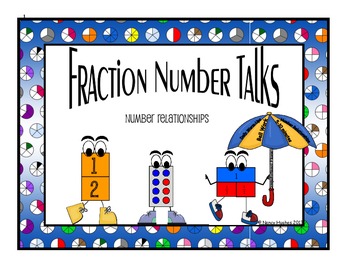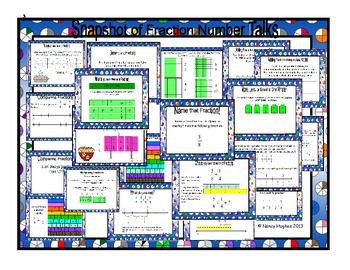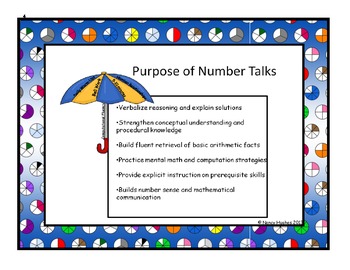Fraction Number Talks
Nancy Hughes
475 Followers
Resource Type
Standards
CCSS3.NF.A.1
CCSS3.NF.A.2
CCSS3.NF.A.3
CCSS4.NF.A.1
CCSS4.NF.A.2
Formats Included
- PDF
Pages
111 pages
Nancy Hughes
475 Followers
What educators are saying
Thank you for this wonderful resource. These number talks were very useful and my students loved them.
Description
This file contains fraction number talks that can be used as warm-ups to help students conceptually understand fractions. The files follow the progression of fraction development with early fraction sense and end during middle school. The purpose of fraction number talks is to strengthen both conceptual and procedural understanding of fraction relationships along with practice of mental math skill. In this file, you will find reasoning strategies for fractions ideal for students in intermediate as well as middle school grades. These strategies are for any learner, but, especially for the struggling learner and ideal for Tier 2 and Tier 3 settings.
These research based strategies aligned to Response to Intervention (RtI) and Common Core
These research based strategies aligned to Response to Intervention (RtI) and Common Core
Total Pages
111 pages
Answer Key
N/A
Teaching Duration
N/A
Report this resource to TPT
Reported resources will be reviewed by our team. Report this resource to let us know if this resource violates TPT’s content guidelines.
Standards
to see state-specific standards (only available in the US).
CCSS3.NF.A.1
Understand a fraction 1/𝘣 as the quantity formed by 1 part when a whole is partitioned into 𝘣 equal parts; understand a fraction 𝘢/𝑏 as the quantity formed by 𝘢 parts of size 1/𝘣.
CCSS3.NF.A.2
Understand a fraction as a number on the number line; represent fractions on a number line diagram.
CCSS3.NF.A.3
Explain equivalence of fractions in special cases, and compare fractions by reasoning about their size.
CCSS4.NF.A.1
Explain why a fraction 𝘢/𝘣 is equivalent to a fraction (𝘯 × 𝘢)/(𝘯 × 𝘣) by using visual fraction models, with attention to how the number and size of the parts differ even though the two fractions themselves are the same size. Use this principle to recognize and generate equivalent fractions.
CCSS4.NF.A.2
Compare two fractions with different numerators and different denominators, e.g., by creating common denominators or numerators, or by comparing to a benchmark fraction such as 1/2. Recognize that comparisons are valid only when the two fractions refer to the same whole. Record the results of comparisons with symbols >, =, or <, and justify the conclusions, e.g., by using a visual fraction model.





